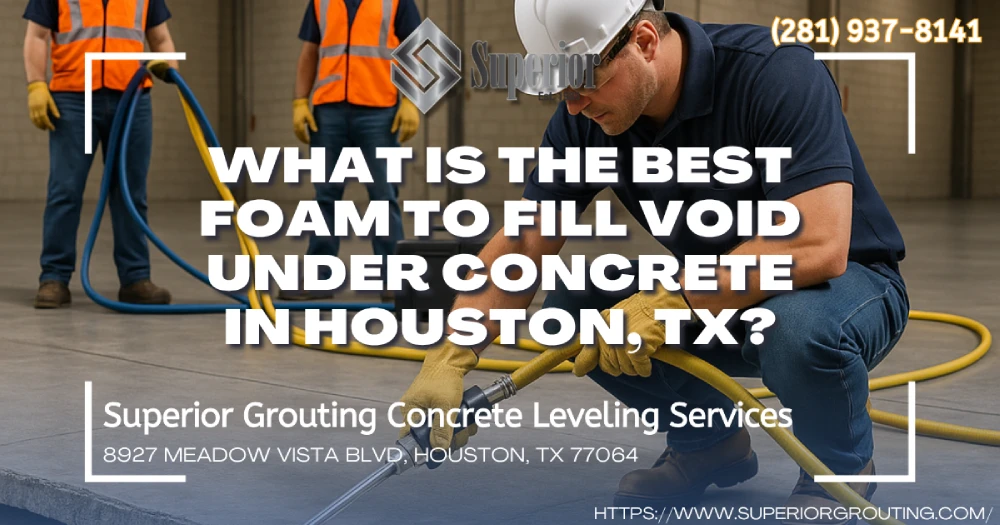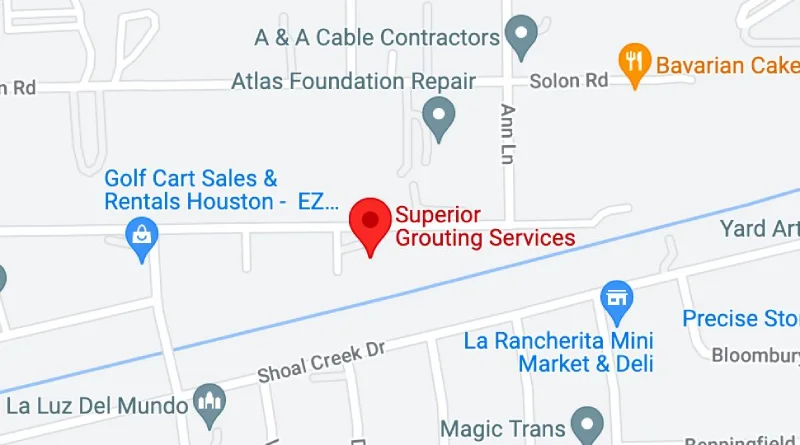What Is The Best Foam To Fill Void Under Concrete in Houston, TX?

Concrete structures across Houston’s ports, plants, and distribution yards endure punishing loads, frequent flooding, and the constant swell-shrink cycle of Gulf Coast clay. When that shifting soil creates dangerous voids under concrete slabs, the fastest, most reliable way to restore grade and capacity is to use expanding, high-density polyurethane foam. Below you’ll discover how polyurethane foam injection outperforms traditional concrete replacement and mudjacking, why the foam expands to fill voids without over-loading sub-grade, and how Superior Grouting’s cutting-edge polyurethane foam solutions make concrete lifting and leveling efficient, precise, and budget-friendly.
Key Takeaways
- Polyurethane foam expands to fill voids precisely, restoring slab support with minimal intrusion. It cures fast, reducing downtime and allowing heavy equipment to resume use within 30–60 minutes.
- Compared to mudjacking or replacement, polyurethane foam is lighter, cleaner, and waterproof. It lifts slabs without overloading soil, making it ideal for Houston’s expansive, erosion-prone subgrades.
- Foam injection uses small drill ports, reducing surface disruption. Technicians use real-time leveling tools to ensure accurate lifts and prevent over-raising, preserving the concrete's structural integrity.
- Custom foam densities match project demands, from light-duty voids to high-traffic zones like ports and distribution centers. This ensures long-term performance without unnecessary material or cost.
- ASTM-compliant polyurethane resists water and chemicals, maintaining stability in Houston’s variable climate. Its inert, closed-cell structure makes it a dependable, environmentally friendly solution for concrete lifting and leveling.
Why Voids Form Beneath Concrete Slabs in Houston
- Aggressive moisture swings make Houston clay swell when saturated, then shrink during drought. The shrink cycle leaves an empty pocket—or void—beneath the concrete surface.
- Continuous forklift or crane traffic “pumps” fine soil out of micro-cracks, enlarging those voids under concrete slabs.
- Aging underground utilities leak, washing sand and silt out from beneath the concrete, accelerating settlement.
If you ignore that gap, the slab loses support, creating rocking panels, broken joints, and expensive downtime. Filling voids quickly keeps the integrity of the existing concrete intact and avoids total concrete replacement.
Polyurethane Foam vs. Traditional Options
Many managers still picture mudjacking when they think about concrete repair. Yet today’s industrial facilities prefer polyurethane foam concrete lifting because it delivers higher performance with less disruption.
| Attribute | Polyurethane Foam Injection | Cementitious Mudjacking | Full Concrete Replacement |
| Hole Size | ⅝"–¾" | 1½"–2" | Excavation required |
| Added Load | 2–10 lb/ft³ foam is inert | 100–140 lb/ft³ slurry | Entire new slab |
| Cure Time | 15–30 minutes | 1–2 days | 7–28 days |
| Water Resistance | Closed-cell, non-absorbent | Porous | Depends on mix |
| Production Downtime | Minimal | Moderate | High |
| Life Cycle Cost | Low | Medium | Highest |
The unmistakable advantage of polyurethane foam is that the foam is injected as a liquid, then expands to fill voids completely, bonds with the concrete, cures quickly, and resists wash-out. The result: lifted concrete that can re-open to traffic the same shift.
How Polyurethane Foam Injection Works
- Precision-drilled ⅝" ports are placed in a calculated grid pattern across the sunken concrete slab.
- Two liquid components are injected beneath the concrete, where the chemical reaction generates a controlled, high-density polyurethane foam.
- The foam expands up to 25 times its liquid volume, creating gentle hydrodynamic pressure that lifts and levels the concrete surface.
- Within minutes the foam cures, forming a rigid, water-resistant matrix that supports the slab and stabilizes the underlying soil.
- Ports are patched flush, and the area is ready for forklifts, cranes, or truck traffic—no lengthy shutdown required.
Because the foam cures to a closed-cell structure, it will not degrade, leach, or absorb water. Polyurethane foam maintains long-term dimensional stability, a crucial factor for pavement around the Houston Ship Channel where groundwater fluctuations are routine.
Selecting the Correct Foam Density
Not all polyurethane foams are identical. Superior Grouting uses specialized formulations tailored to each concrete lifting project:
- 3–4 lb/ft³ foam for light, deep-cavity void filling services under non-traffic areas, such as pipe racks or tank rings.
- 4–6 lb/ft³ high-density polyurethane foam for routine concrete leveling of warehouse slabs or rail aprons.
- 8–10 lb/ft³ structural polyurethane for crane pads, port berths, and heavy industrial floors where compressive strength above 120 psi is mandatory.
This custom approach guarantees the foam beneath a concrete slab delivers exactly the structural punch required without adding unnecessary material costs.
Advantages of Polyurethane Foam Over Traditional Concrete Solutions
- Minimal Intrusion – Pencil-thin ports mean no saw-cutting or large patches on finished concrete surfaces.
- Rapid Return to Service – Foam cures in minutes, allowing operations to resume almost immediately.
- Lightweight Integrity – Polyurethane foam is significantly lighter than mudjacking slurry, so it won’t trigger additional settlement in weak sub-grade.
- Waterproof Barrier – Closed-cell foam blocks future erosion, protecting the integrity of your concrete.
- Clean, Environmentally Responsible – Modern formulations are HFC-free, low-VOC, and completely inert once cured.
In short, polyurethane foam offers superior performance and lower life-cycle cost, making it the smart choice for concrete lifting in Houston’s demanding environment.
The Engineering Behind Effective Concrete Lifting and Leveling
Superior Grouting never relies on guesswork. Each foam injection process begins with:
- Ground-penetrating radar or ultrasonic testing to define voids under concrete.
- Dynamic Cone Penetrometer (DCP) tests verifying sub-grade strength.
- Laser or robotic levels confirming lift elevations to ±1⁄16".
- ASTM D6817-compliant documentation proving material density and compressive strength.
These controls ensure each injection of polyurethane foam beneath the concrete satisfies structural, safety, and TxDOT specifications.
Typical Industrial Applications in Houston
- Stabilizing container-yard pavements at Bayport and Barbours Cut terminals.
- Re-leveling pump pads, compressor slabs, and pipe-rack footings in petrochemical plants.
- Lifting settled bridge approaches on Beltway 8 and IH-10 corridors.
- Filling voids beneath machine foundations and hangar floors at Ellington Field.
- Restoring rutted slab-on-grade aisles inside 24/7 distribution centers.
Across each scenario, polyurethane concrete lifting offers superior speed and durability compared to tearing out and re-pouring traditional concrete.
Cost Considerations and ROI
Pricing for polyurethane concrete raising is calculated by cubic feet of void fill, required foam density, access logistics, and operational constraints (night shifts, traffic control, or confined-space work). Although initial costs can outrun mudjacking, facility managers routinely recover the investment within months by eliminating prolonged shutdowns and extended maintenance cycles.
Safety and Compliance
Superior Grouting crews carry TWIC cards for port access, OSHA 30 credentials, and are trained in HAZCOM and lock-out/tag-out. All polyurethane foam injection equipment is explosion-proof where required and features digital proportioners that maintain exact resin ratios, critical to produce foam that cures consistently and performs for decades.
Why Superior Grouting?
- Decades of Houston-area geotechnical experience
- Proprietary advanced polyurethane foam rigs capable of lifts up to 250 lbs/ft²
- In-house engineering for stamped lift plans
- Warranty backed by third-party material testing
Ready to restore your concrete surfaces? Contact Superior Grouting today. If you need comparative pricing, feel free to contact Leveled Concrete for a second opinion—our data consistently shows polyurethane foam surpasses alternative methods for industrial projects.


